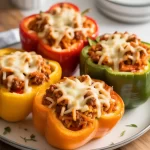As I stood in my kitchen surrounded by the comforting aroma of freshly minced rosemary and the promise of garlic, I realized that crafting your own loaf of roasted garlic and rosemary bread is the delightful ritual you never knew you needed in your life.

The scent of fresh bread, for me, is hard to beat. I don’t, however, make just any bread.
My go-to is a loaf filled with roasted garlic and rosemary, a pan de aceite—a bread made with olive oil, which contributes a kind of velvety texture—to be sure, but also a bread that, when the mood strikes, I may serve with oven-roasted tomatoes, in which case I have no problem calling it a bruschetta bread. Of course, this loaf is equally good sliced and toasted, with just a swipe of butter (for the moment, that is; I’m currently trying to work through some life changes that involve a decline in my consumption of butter and bread) and maybe a sprinkle of rosemary for good measure, if the door to my pantry can swing open wide enough to let all the healthy-looking fresh rosemary in.
Roasted Garlic And Rosemary Bread Recipe Ingredients

- All-purpose flour: Provides a base; rich in carbohydrates for energy.
- Active dry yeast: Leavening agent; creates light, airy texture.
- Olive oil: Adds moisture and richness; healthy monounsaturated fats.
- Garlic: Adds savory depth; known for health-boosting antioxidants.
- Rosemary: Aromatic herb; enhances flavor with a pine-like, earthy taste.
Roasted Garlic And Rosemary Bread Recipe Ingredient Quantities
- 3 1/2 cups all-purpose flour
- 1 1/2 teaspoons salt
- 1 tablespoon sugar
- 2 1/4 teaspoons (1 packet) active dry yeast
- 1 1/4 cups warm water (about 110°F)
- 2 tablespoons olive oil, plus more for drizzling
- 1 head of garlic
- 2 sprigs fresh rosemary, chopped
- 1/4 teaspoon freshly ground black pepper
How to Make this Roasted Garlic And Rosemary Bread Recipe
1. Set your oven to 400 degrees Fahrenheit (200 degrees Celsius). Using a sharp knife, carefully cut off the top part of the head of garlic so that the individual cloves are exposed. Drizzle some good quality olive oil over the exposed cloves, sprinkle with a little salt and pepper, wrap the head of garlic tightly in aluminum foil, and place it directly on the oven rack.
2. In a sizable basin, mix the tepid water and sugar. Pour the yeast on top and allow it to rest for about 5-10 minutes, until it is frothy.
3. Incorporate the olive oil, salt, and squeezed roasted garlic cloves into the stir. Blend well for even mixing.
4. Slowly add the flour and mix with a wooden spoon until a coarse dough forms. If necessary, add in the chopped rosemary and black pepper and knead the mixture to incorporate it well.
5. Lightly flour a work surface, then turn the dough out onto it. Knead by hand for about 8-10 minutes until the dough is smooth and elastic.
6. Put the dough in a bowl that has been lightly oiled, turning the dough once to coat it lightly with oil. Cover the bowl with a damp towel and place it in a warm location. Allow the dough to rise until it has more than doubled in size and looks puffy, about 1 to 2 hours.
7. The dough should be punched down and shaped into a round loaf. This loaf should then be placed on a baking sheet that is lined with parchment paper.
8. Set your oven to 375°F (190°C). Make 1-2 shallow cuts on the top of the loaf. Brush with olive oil, and if you like, sprinkle a bit of extra rosemary and salt.
9. Bake the bread for 30 to 35 minutes. It is done when it is golden brown and sounds hollow when you tap it on the bottom.
10. Completely cool the bread on a wire rack before slicing and serving. Enjoy your homemade roasted garlic and rosemary bread!
Roasted Garlic And Rosemary Bread Recipe Equipment Needed
1. Oven
2. Sharp knife
3. Aluminum foil
4. Baking sheet
5. Parchment paper
6. Sizable mixing bowl
7. Wooden spoon
8. Small bowl or cup (for yeast proofing)
9. Measuring cups and spoons
10. Wire rack
11. Damp towel or kitchen towel (for covering dough)
12. Pastry brush (for brushing olive oil)
13. Work surface (for kneading dough)
FAQ
- Q: Can I use whole wheat flour instead of all-purpose flour?A: You can use whole wheat flour instead, but your end product will be denser. You might consider using a blend with all-purpose flour to achieve a lighter texture.
- Q: How do I roast the garlic for this recipe?A: Cut the top off the garlic head, and drizzle on the olive oil. Wrap in foil, place in a 400°F oven, and roast for 30-40 minutes until the garlic is golden and soft.
- Q: Can I use dried rosemary if I don’t have fresh?A: Yes, you can use dried rosemary instead. Use roughly 1 tablespoon of dried rosemary, as it is more concentrated than the fresh type.
- Q: How do I know when the bread is done baking?A: The loaf is finished when it sounds hollow when struck and has a crust that is golden brown, usually after being baked for 25-30 minutes at 375°F.
- Q: Can this recipe be made in a bread machine?Yes, this bread machine recipe can be carried out. In order to do so, ingredients must be added in the prescribed sequence as dictated by the bread machine’s instructions.
- Q: How should I store the leftover bread?B. Keep an airtight container at room temperature, and use it to store the bread for up to 3 days. If you need to keep it longer than that, pop it into the freezer. Before serving, refresh it by toasting. I find that the method used to store it makes a huge difference in taste and texture.
Roasted Garlic And Rosemary Bread Recipe Substitutions and Variations
All-purpose flour can be substituted with either whole wheat flour, for a denser texture, or bread flour, for a chewier loaf.
Sweeten with honey or maple syrup instead of sugar.
Instant yeast: Use the same amount as a direct substitute for active dry yeast; no need to dissolve it in water first.
Instead of olive oil, consider trying melted butter or avocado oil for a different flavor. Olive oil is A Mediterranean mainstay, but if you use it for frying or in any recipe where its flavor might be too pronounced, you could try these alternatives.
If fresh rosemary is not available, substitute with 1 tablespoon dried rosemary.
Pro Tips
1. Roast the Garlic Ahead To enhance the flavor, roast the garlic a day ahead and let it infuse more deeply. You can also squeeze out the roasted garlic and mix it with olive oil to let the flavors meld overnight.
2. Enhance Yeast Activation Ensure the water is at the right temperature (about 110°F). If it’s too cool, the yeast won’t activate well; if it’s too hot, it could kill the yeast. A kitchen thermometer can help check the temperature accurately.
3. Use a Bench Scraper for Kneading A bench scraper can be very helpful for turning and cutting the dough while kneading, keeping your hands less sticky and making the process cleaner and more efficient.
4. Create a Steamy Baking Environment For a crustier loaf, place a small oven-safe dish with water on the bottom rack of the oven while baking the bread. The steam created will help develop a beautiful crust.
5. Customize with Extra Flavors Feel free to add other herbs like thyme or oregano, or a sprinkle of parmesan for extra flavor. Just be cautious with the amounts so the flavors don’t overpower the garlic and rosemary.

Roasted Garlic And Rosemary Bread Recipe
My favorite Roasted Garlic And Rosemary Bread Recipe
Equipment Needed:
1. Oven
2. Sharp knife
3. Aluminum foil
4. Baking sheet
5. Parchment paper
6. Sizable mixing bowl
7. Wooden spoon
8. Small bowl or cup (for yeast proofing)
9. Measuring cups and spoons
10. Wire rack
11. Damp towel or kitchen towel (for covering dough)
12. Pastry brush (for brushing olive oil)
13. Work surface (for kneading dough)
Ingredients:
- 3 1/2 cups all-purpose flour
- 1 1/2 teaspoons salt
- 1 tablespoon sugar
- 2 1/4 teaspoons (1 packet) active dry yeast
- 1 1/4 cups warm water (about 110°F)
- 2 tablespoons olive oil, plus more for drizzling
- 1 head of garlic
- 2 sprigs fresh rosemary, chopped
- 1/4 teaspoon freshly ground black pepper
Instructions:
1. Set your oven to 400 degrees Fahrenheit (200 degrees Celsius). Using a sharp knife, carefully cut off the top part of the head of garlic so that the individual cloves are exposed. Drizzle some good quality olive oil over the exposed cloves, sprinkle with a little salt and pepper, wrap the head of garlic tightly in aluminum foil, and place it directly on the oven rack.
2. In a sizable basin, mix the tepid water and sugar. Pour the yeast on top and allow it to rest for about 5-10 minutes, until it is frothy.
3. Incorporate the olive oil, salt, and squeezed roasted garlic cloves into the stir. Blend well for even mixing.
4. Slowly add the flour and mix with a wooden spoon until a coarse dough forms. If necessary, add in the chopped rosemary and black pepper and knead the mixture to incorporate it well.
5. Lightly flour a work surface, then turn the dough out onto it. Knead by hand for about 8-10 minutes until the dough is smooth and elastic.
6. Put the dough in a bowl that has been lightly oiled, turning the dough once to coat it lightly with oil. Cover the bowl with a damp towel and place it in a warm location. Allow the dough to rise until it has more than doubled in size and looks puffy, about 1 to 2 hours.
7. The dough should be punched down and shaped into a round loaf. This loaf should then be placed on a baking sheet that is lined with parchment paper.
8. Set your oven to 375°F (190°C). Make 1-2 shallow cuts on the top of the loaf. Brush with olive oil, and if you like, sprinkle a bit of extra rosemary and salt.
9. Bake the bread for 30 to 35 minutes. It is done when it is golden brown and sounds hollow when you tap it on the bottom.
10. Completely cool the bread on a wire rack before slicing and serving. Enjoy your homemade roasted garlic and rosemary bread!






